AAA: How Old Are Things?
Ever wondered how astronomers can casually claim that the sun is 5 billion years old or that the universe is pushing 13.8 billion? In this fascinating blog, Kielder Observatory's astronomer Rosie pulls back the cosmic curtain to reveal the science behind those staggering numbers. From ancient guesses to salty oceans to radioactive decay and meteorite time capsules, she traces the journey of how we've come to understand the age of the Earth, the Solar System and even the stars themselves. Spoiler Alert: It's not guesswork - it's science (mostly).
You're having a lovely time at Kielder Observatory, seeing the telescopes, holding meteorites, learning about stars and planets. And then an astronomer will blurt out an absurdly old age like "The Sun is about 5 billion years old", or "our Universe is 13.8 billion years old", or amusingly "those stars over there are only 100 million years old, practically babies". Are we just pulling numbers out of thin air? Are we lying and astronomy is the greatest magic trick of all time? How could we know this?
Finding out the age of objects in space is a difficult and complicated thing to do, and saying these numbers so nonchalantly is a disservice to the many scientists and years of hard work to figure this out. However, if we were to explain in detail how we know every scientific fact we say during a telescope tour, we'd have to extend our events so long it would be morning by the time you'd leave.
So instead, here I am writing this article, and I will explain in detail how we find these things out. There are so many different areas to cover, so I'm going to start at the beginning of our scientific history about this subject - how we discovered the age of our Earth.
The Earth and our Solar System
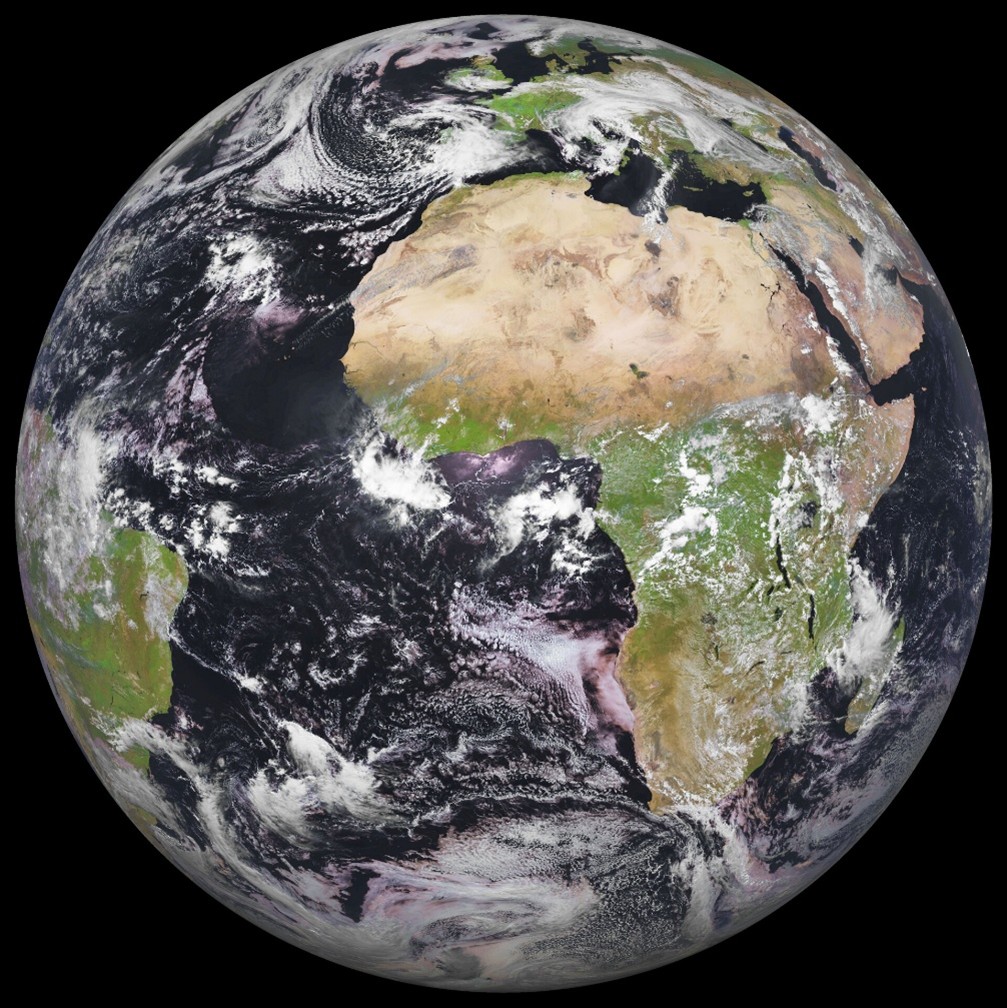
(Image: The Earth. Credit: ESA)
We've been trying to figure out how old the Earth is for a very long time. Many cultures believed the Earth was infinitely old, such as the Ancient Greeks. During medieval time Christians scrutinized the bible for clues and estimated it was only a few thousand years old. However, during the 1700 and 1800's we tried to find the answer more scientifically.
Some scientists looked at the amount of salt in the ocean and tried to calculate how long it would have taken to get that salty from the surounding rock. Others assumed that the Earth must have started out completely molten, and worked out the amount of time it would take the surface to cool to what it is today. Both of these methods came out with an age of around a few 100 million years, even at the time this was seen as much too short - especially by biologists.
It wasn't until radiometric dating, a method devised in the early 20th century, that we finally discovered the true age of the Earth.
Radiometric dating is an incredibly powerful scientific method. It works by looking at the amount of radioactive elements in rocks. Radioactive elements decay into smaller elements, for example uranium-238 slowly decays into lead (Pb) at a known rate. If you have 1kg of uranium, in about 4.47 billion years, only 0.5kg of uranium-238 will be left and the rest will have decayed into lead (Pb). So, if we look at a piece of rock and compare ratios between uranium-238 and lead, we can get an idea of how old that rock must be!
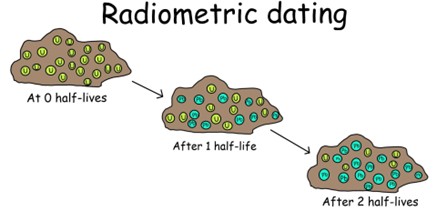
(Image: A rock containing uranium decaying into lead over time. A half-life is how long it takes for a radioactive element to decay half of its initial quantity. Credit: Unkown)
At first, scientists found rocks which were a few hundred million up to 2 billion years old. Physicist Arthur Holmes, who led the way for radiometric dating, in 1927 presented results in a paper saying the Earth was at least 1 billion and up to 3 billion years old.
Now, at this point in history we had already established a theory on how the Earth and Solar System had formed - namely the nebula hypothesis which put briefly: the entire solar system formed out of the same cloud of gas and dust at the same time. First the Sun formed, and then shortly after the planets clumped and ended up orbiting around the Sun. So, if we find the age of the Earth, we find the age of the entire Solar System, but indeed it also works the other way around.
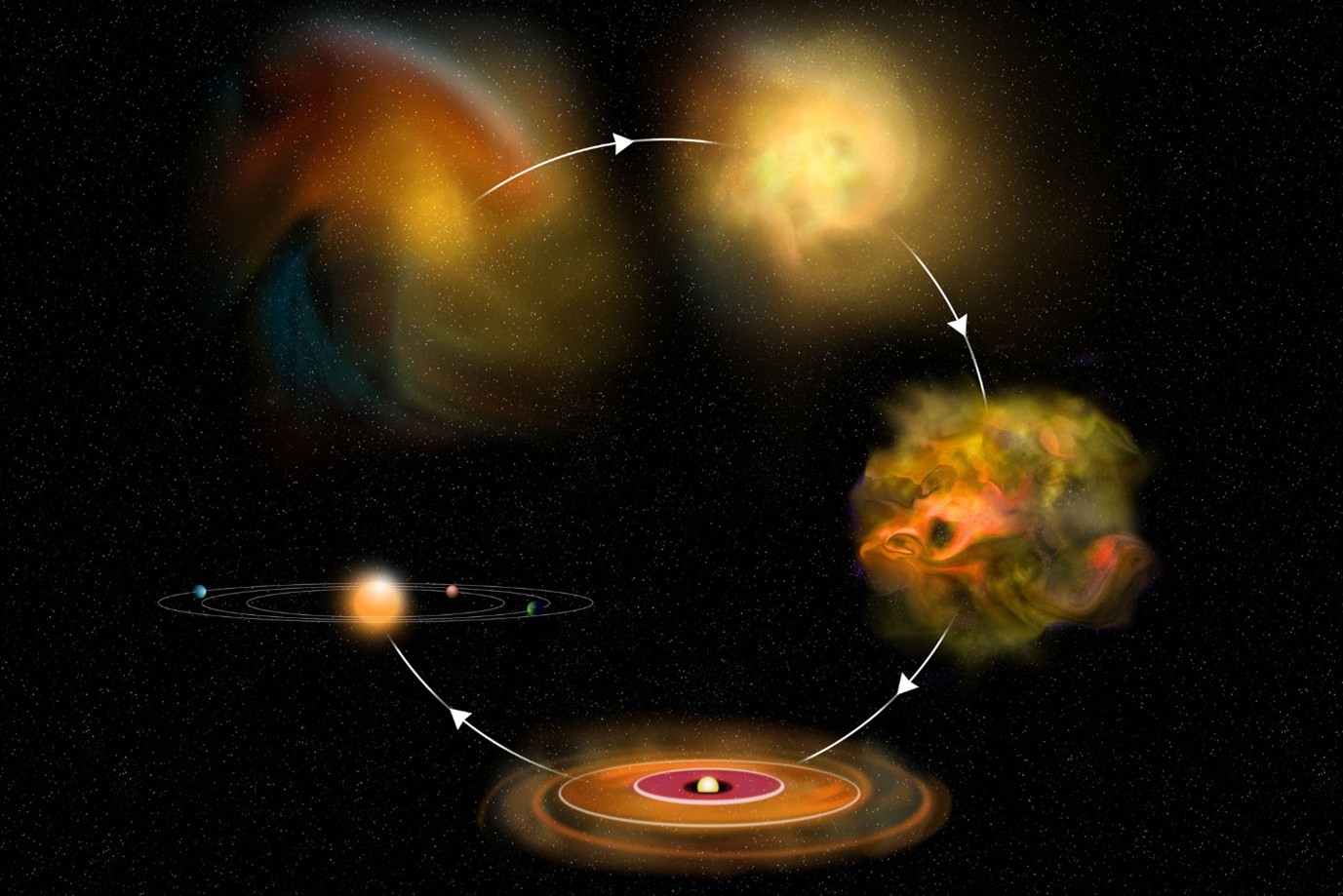
(Image: Formation of the Solar System / nrao.edu)
In the 1950's geochemist Clair Cameron Patterson started looking into the age of a few meteorites - bits of rock from space that have crashed into Earth. Unlike Earth rock which has been renewed and melted many times due to the tectonic plates, bits of rock in space have been frozen and unchanged since the formation of the Solar System, and therefore give a more accurate age.
He analysed the famous Canyon Diablo meterorite and in 1956 published "Age of Meteorites and the Earth" showing the age to be 4.550Gy ± 70My, which has remained the age of the Solar System and the Earth ever since.

(Image: Fragment of Canyon Diablo meteorite. Credit: Aerolite Meteorites of Tuscon)
Stars
So, we figured out the age of the Solar System - hoorah! Now, what about the rest of space?
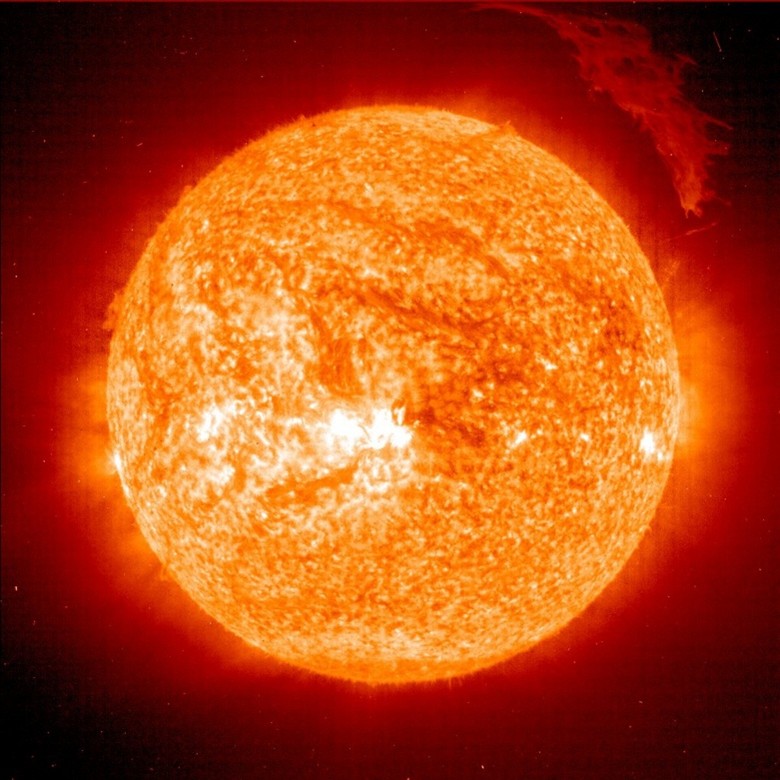
(Image: The Sun, 4.6 billion years old. Credit: ESA)
It's complicated..
We know how old our Sun is because we've sampled rocks that were nearby it, we don't have that luxury for other stars sadly.
If you thought finding the age of rocks was complicated, I have some bad news for you. Finding out the age of stars is very difficult and even with all of our fancy equipment and analysis and modelling techniques, is still a guestimation of sorts. And here's a secret - we can't find out the age of most stars.
Our Sun is in the main part of its life and is what's called a main sequence star (not too big or too small). The Sun and other stars on the main sequence are made of hydrogen and are fusing the hydrogen at the core producing energy. They do this from the very beginning of their lives all the way until their death, constantly producing energy at their core.
The trouble is, stars churn out this energy pretty consistently for the majority of their lives, making it difficult to tell how old they are. When we look at the light from our Sun, it looks pretty much the same as it would have a billion years ago, and will look the same a billion years in the future. For 90% of it's life, a star will pretty much look identical, burning hydrogen and churning out light and heat.
However, different sizes of stars look very different.

(Image: The more massive the star, the hotter and more luminous it is. Stars decreasing in mass from left to right.
Credit: ZME Science)
Big stars have a lot of mass and burn the hydrogen in the core very quickly. Therefore, producing lots of heat and light. They are the hottest, bluest, brightest stars, but because they burn up the hyrdogen so fast, they dont live very long.
Smaller stars burn the hydrogen much more slowly, so they don't glow very hot or bright -maybe just a nice yellow or amber colour. But they live a much longer time.
So, if we know how massive the star is, we know roughly the age expectancy. But still we don't know how long it's been there.
The secret lies in death...
At the end of a star's life their colour and their luminosity change, and we can use this to our advantage.
When the grim reaper comes knocking on a star's door, the star begins to expand and the surface of the star cools down. Because it's size has increased it's still luminous, but the colour changes to a redder hue. By looking at stars whose colour is perhaps redder than it should be, we can tell if it's nearing towards death (or about to fall off the main sequence).
And if we see that it's on the cusp of falling off the main sequence, we can get an estimate of it's age! Hoorah!
Let's take the famous star Betelgeuse as an example.
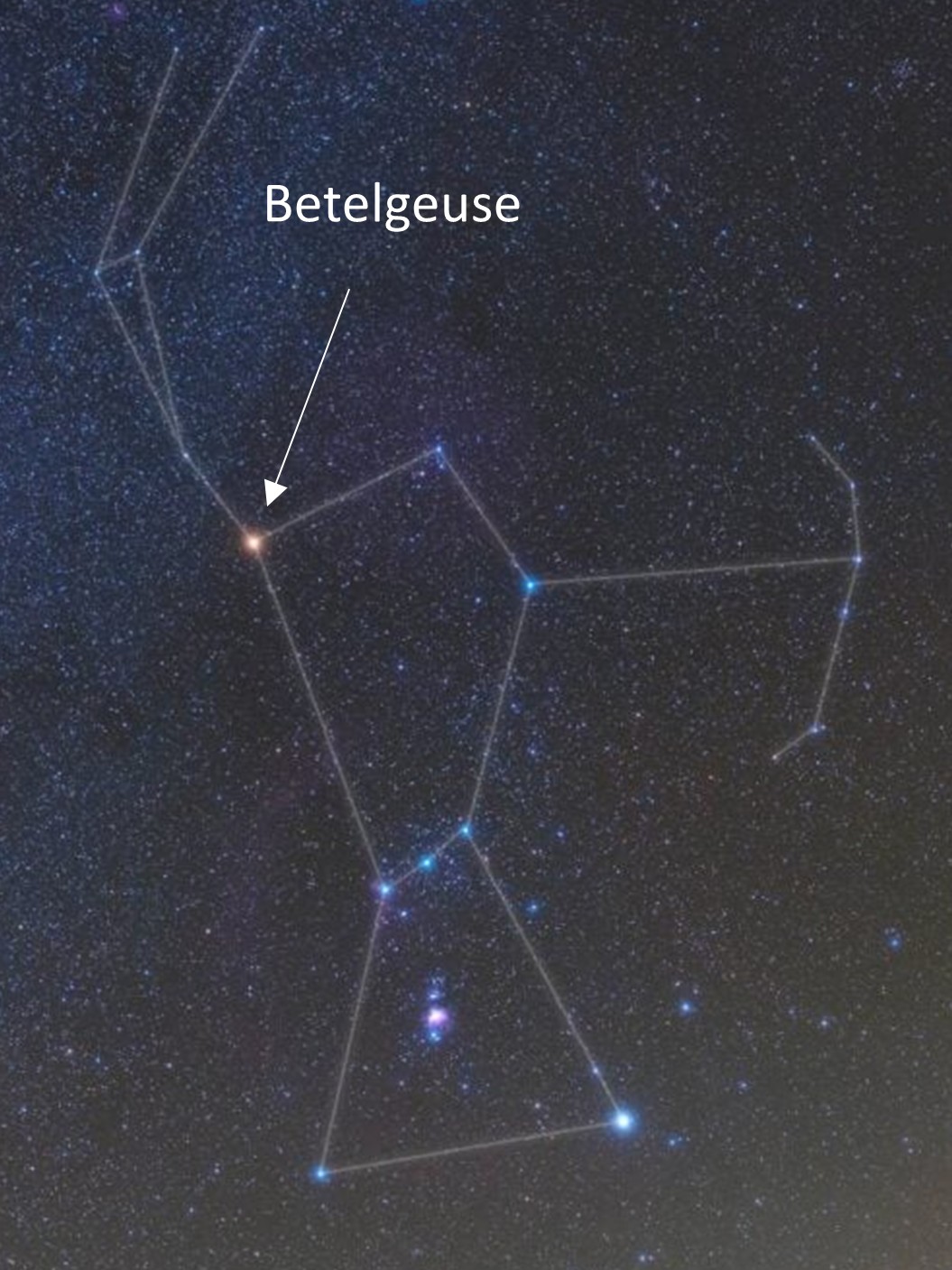
(Image: Betelgeuse in the constellation of Orion. Credit: Astrobackyard)
Using observations such as luminosity and temperature, we can estimate Betelgeuse to be 15 to 20 times the mass of our Sun. It's also very red and extremely luminous meaning that it's towards the end of its life in the "red supergiant" phase. Now, a star 15-20 times the mass of our Sun would take somewhere between 8 and 15 million years to reach the red supergiant stage. So, we can estimate Betelgeuse is around 8-15 million years old!
For the most part finding the age of an individual star is near impossible. So we use clusters instead.
Star Clusters
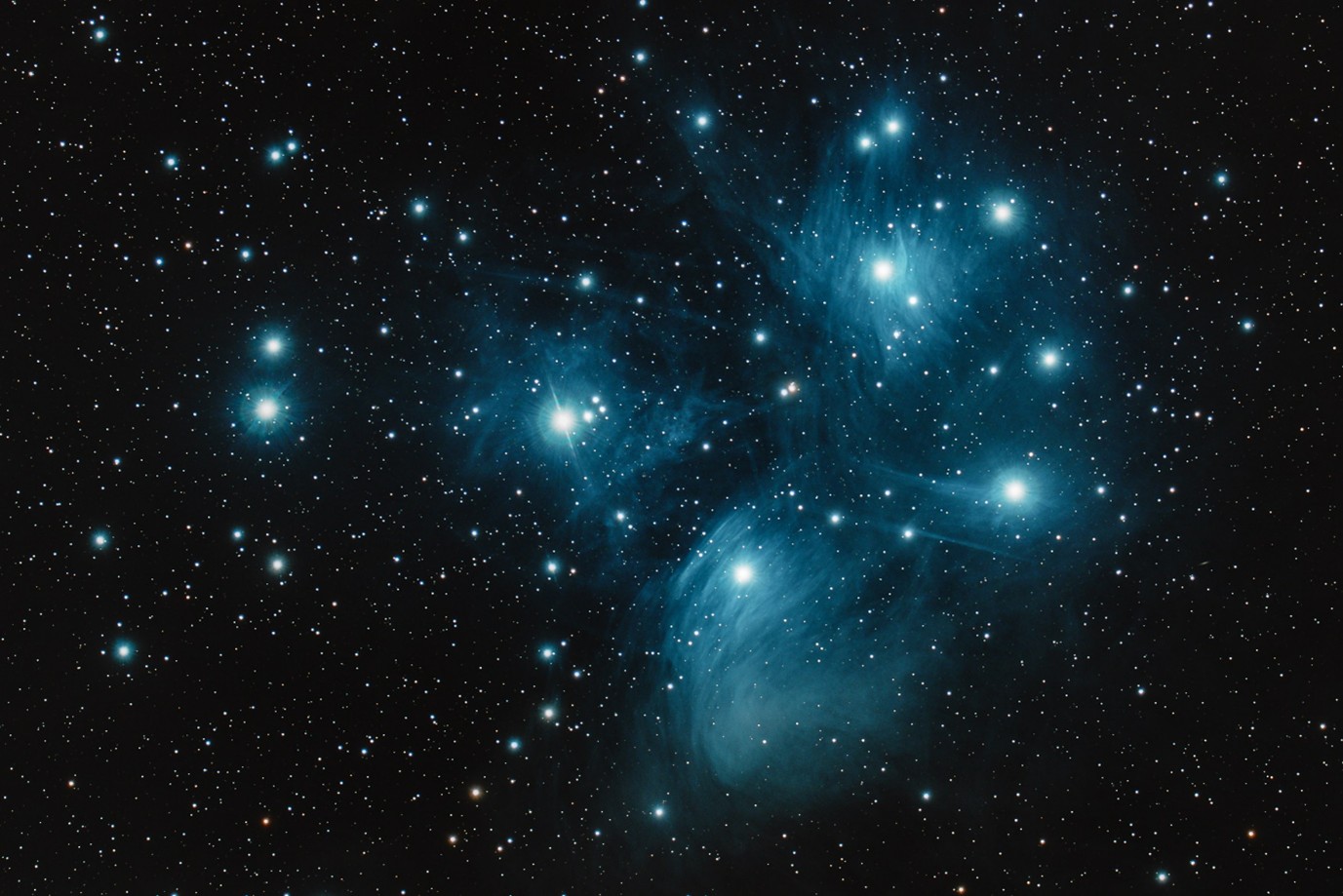
(Image: The beautiful Pleiades! Taken with our remote telescope in Spain by Adam Shore. Credit: Kielder Observatory.)
Star clusters are groups of stars that have all been born together at the same time. The different massed stars in a cluster will burn through their fuel at different speeds. But because all the stars in a cluster are the same age, we can compare their different stages of life, and it makes it much easier to find their age.
For example, take the beautiful Pleiades or seven sisters as pictured. We can measure that those beautiful teal coloured stars are very hot, and very luminous. So that tells me they are pretty massive, probably a few times the mass of our Sun, and much hotter. Massive stars don't live very long so we can guestimate that this is quite a young cluster. But how young exactly?
We can plot all the stars in the Pleiades (there's about 1000) according to their temperature and luminosity on a HR (Hertzpring-Russell) diagram.
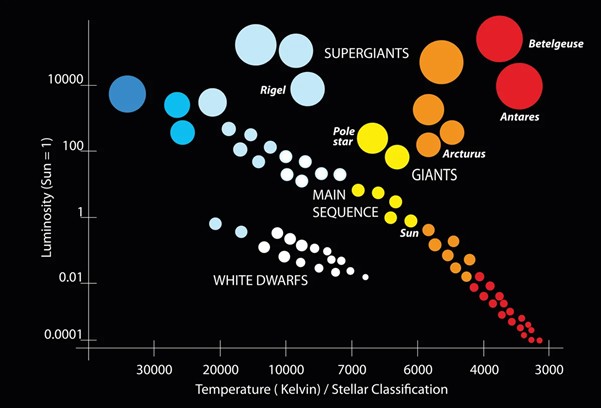
(Image: A schematic Hertzprung-Russell diagram showing where the main sequence and other portions of stars exist in this classification. Credit: gstraub/Shutterstock.com)
When the star cluster is first born, the HR diagram is a beautiful straight line. But the older the cluster gets, more and more stars start to die, and the straight line starts to curve. The massive stars are the first ones to leave the main sequence as they run out of fuel first. But as the cluster ages, the medium sized stars and even small stars start to run out of fuel and fall off the main sequence. Seeing where this "turn-off" point is, we can estimate how old the cluster is.

(Image: Plotting the temperature and luminosity of all the stars in a cluster can give us an estimate of the age. On the left, a very young cluster with few of the bright blue stars dying. On the right, an older cluster where all the bright blue stars and even medium yellow stars are marching on the path towards death. Credit: Milwaukee Area Technical College)
So back to the Pleiades. If we plot all the stars in the cluster on a graph based on their luminosity and temperature, it looks like the diagram below. As you can see there is already a slight curve towards the left, so it's not brand new, but it's still a fairly young cluster. Current estimates say around 100-130 million years old.
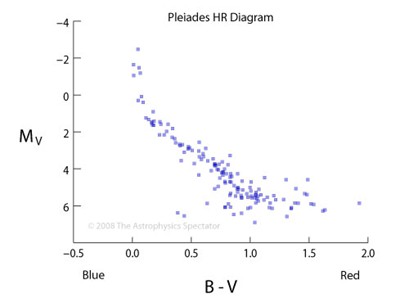
(Image: The Pleiades HR Diagram. Credit: The Astrophysics Spectator)
Galaxies
Galaxies are quite tricky to find the age of. Part of the problem is deciding when the galaxy "began". Galaxies like our own Milky Way began with a few star clusters merging to become a small galaxy. And then a few smaller galaxies merged until finally we have our Milky Way.
The best thing we can do is look at the age of the stars. Stars are the building blocks of galaxies, so to find out how old a galaxy is we look at the oldest stars in that galaxy.
With our Milly Way, we've found stars which are almost as old as the universe itself! With estimates of around 13 billion years old.

(Image: Artist's impression of the Milky Way. Credit: NASA)
Phew! That was complicated. As you can see it's not easy telling how old objects are in space. But astronomers have come up with a few tricks which help us out.
References and extra reading!
https://science.howstuffworks.com/how-old-is-earth.htm
https://doi.org/10.1016/0016-7037(56)90036-9 -Clair Pattersons paper on the age of the Earth
https://www.skyatnightmagazine.com/space-science/how-old-is-sun
https://www.skyatnightmagazine.com/space-science/age-of-stars
https://www.scientificamerican.com/article/how-do-scientists-determi/
https://www.iflscience.com/how-do-we-know-the-age-of-stars-68575
https://www.sciencenews.org/article/star-age-calculation-astronomy-life-cycle
https://www.skyatnightmagazine.com/space-science/how-old-milky-way-galaxy
https://www.youtube.com/watch?v=w80z_moI8BU-(Fantastic video by science news with some cool visualisations)
















